Awadhi cuisine
Awadhi cuisine (Hindi: अवधी पाक-शैली, Urdu: اودھی کھانا) is a cuisine native to the Awadh region in Northern India.[1] The cooking patterns of Lucknow are similar to those of Central Asia, the Middle East, and Northern India with the cuisine comprising both vegetarian and non-vegetarian dishes. The Awadh region has been greatly influenced by Mughal cooking techniques, and the cuisine of Lucknow bears similarities to those of Central Asia, Kashmir, Punjab and Hyderabad. The city is also known for its Nawabi foods.[2]
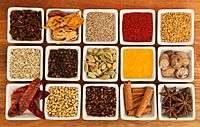 |
| This article is part of the series on |
| Indian cuisine |
|---|
|
Regional cuisines
|
|
Ingredients, types of food
|
|
See also
|
|
Related cuisines |
|
Early history

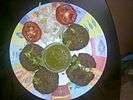
The bawarchis (chefs) and rakabdars (gourmet cooks) of Awadh invented the dum style of cooking or the art of cooking over a slow fire, which has become synonymous with Lucknow today.[3] Their spreads consisted of elaborate dishes such as kebabs, kormas, biryanis, kaliyas, nahari-kulchas, zarda, sheermal, rumali rotis, and warqi parathas. The richness of Awadh cuisine lies not only in the variety of cuisine but also in the ingredients used like mutton, paneer, and rich spices, which include cardamom and saffron.

Kebabs are an integral part of Awadhi. Lucknow is proud of its Kebabs. There are several varieties of popular kebabs in Awadhi cuisine viz. Kakori Kebabs, Galawat ke Kebabs, Shami Kebabs, Boti Kebabs, Patili-ke-Kebabs, Ghutwa Kebabs and Seekh Kebabs are among the known varieties.
The kebabs of Awadhi cuisine are distinct from the kebabs of Punjab insofar as Awadhi kebabs are grilled on a chula and sometimes in a skillet as opposed to grilled in a tandoor in Punjab. Awadhi kebabs are also called "chula" kebabs whereas the kebabs of Punjab are called "tandoori" kebabs.
List of popular kebabs
The Seekh kebab has long been considered a piece de resistance in the Awadhi dastarkhwan. Introduced by the Mughals it was originally prepared from beef mince on skewers and cooked on charcoal fire. Now lamb mince is preferred for its soft texture.
The 100-year-old Tunde ke Kabab in Chowk is the most famous outlet for Kababs even today.[4] Tunde kabab is so named because it was the speciality of a one-armed chef. The tunde kabab claims to be unique because of the zealously guarded family secret recipe for the masala (homemade spices), prepared by women in the family. It is said to incorporate 160 spices.
Kakori kabab is considered blessed since it was originally made in the place by the same name in the dargah of Shah Abi Ahder Sahib with divine blessings. The meat used is from the tendon of the leg of mutton, combined with khoya and spices.
Shami kebab is made from mincemeat, usually with chopped onion, coriander, and green chillies added. The kebabs are round patties filled with spicy mix and tangy raw green mango. The best time to have them is in May, when mangoes are young. When mangoes are not in season, kamrakh or karonda may be substituted for kairi, as both have a tart flavour reminiscent of raw mango.
A variant made without any admixture or binding agents and comprising just the minced meat and the spices is the Galawat kabab.
An unusual offering is the Pasanda kebab, piccata of lamb marinated and then sautéed on a griddle.
Boti kebab is lamb marinated in yoghurt and cooked on skewers in a tandoor oven.
Vegetarian kebabs include Dalcha Kebab, Kathal ke Kebab, Arbi ke Kebab, Rajma Galoti Kebab (kidney bean kebab cooked with aromatic herbs), Zamikand ke Kebab (Lucknowi yam kebabs), etc.
Here is the list of some popular kebabs[5]
- Kakori kebabs
- Kebabs of Galawat
- Shami kebabs
- Boti kebabs
- Patili-ke kebabs
- Ghutwa kebabs
- Seekh kebabs
Culinary terms and techniques
Awadhi cuisine, although similar to Mughlai cuisine, differentiates on the methodology of cooking. Its uniqueness comes from the slow preparation and layering of flavour in dishes. Where Mughal dishes are rich in fats due to excessive use of milk, cream and spices, Awadhi food is more subtle with just handful of spices. Rampur and Lucknow are not too far geographically but their culinary styles are too different. Rampuri cuisine was influenced by Afghani culture and they roughly use spices whereas Awadhi cuisine uses only nearly 20 spices but they take out the flavour of each ingredient. Some Awadhi culinary techniques are given:
- Dum Dena
- Gile Hikmat
- Bhagona
- Deg/Degchi
- Seeni
- Durust Karna
- Ghee Durust Karna
- Dhungar/Dhuaan
- Bhagar
- Galavat
- Kadhai
- Lagan
- Loab/Rogan
- Moin
- Lobe Ka Tandoor
- Yakhni Cuts
- Zamin Doz
- Mahi Tawa
- Ittr[6]
Curry preparations
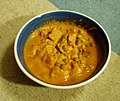
Korma is actually the Indian name for the technique of braising meat. It originated in the lavish Moghul cuisine wherein lamb or chicken was braised in velvety, spiced sauces, enriched with ground nuts, cream and butter. While kormas are rich, they are also mild, containing little or no cayenne or chillies.[7] There are both vegetarian (navratan korma) and non-vegetarian (chicken, lamb, beef and fish korma) varieties of korma. Murgh Awadhi Korma is a classic from Lucknow.[8]
Rice preparations
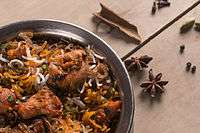
Pulao is made by cooking meat in ghee with warm aromatic spices and then layered with meat curry or marinade (depending on the type of biryani), then sealed and cooked over low heat until done. The vegetarian version is called tehri.
Bread preparations
As wheat is the staple food of the state, breads are very significant. Breads are generally flatbreads baked in a pan; only a few varieties are raised breads. Improvisations of the roti (or bread) are of different types and made in various ways and include the rumaali roti, tandoori roti, naan (baked in a tandoor), kulcha, lachha paratha, sheermaal and Bakarkhani.
Breads made of other grains have descriptive names only, thus we have Makai ki roti, Jowar ki roti (barley flour roti), Bajre ki roti (bajra is a grain only grown in India), chawal-ki-Roti (roti of rice flour).
- Chapati is the most popular roti in India, eaten for breakfast, lunch, or dinner.
- Puri are small and deep-fried so they puff up.
- Paratha is a common roti variant stuffed with fillings of vegetables, pulses, cottage cheese, and even mincemeat and fried in ghee or clarified butter. This heavy and scrumptious round bread finds its way to the breakfast tables of millions.
- Rumali Roti is a thin bread baked on a convex metal pan. The Urdu/Hindi word rumaali means handkerchief.
- Tandoori Roti is thicker bread that is baked in a tandoor, and can be crispy or chewy depending on its thickness.
- Naan is a pan-baked soft thick bread.
- Sheermaal is a sweet baked yeast naan made with flour, milk, sugar, and saffron.
- Baqarkhani is a variation of sheermaal that is cooked on a griddle rather than baked.
Desserts

Winters are dedicated to halwas of all kinds that came to stay in India. There are several varieties of these, prepared from different cereals, such as gram flour, sooji, wheat, nuts, and eggs. The special halwa or halwa sohan, has four varieties: Papadi, Jauzi, Habshi, and Dudhiya.
Chaat
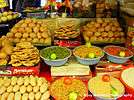
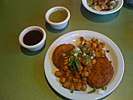
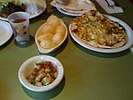
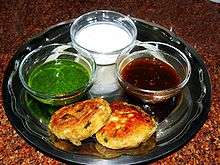
Chaat and Samosa originated in Uttar Pradesh but now are popular nationwide and abroad. these are an integral part of street foods across India. The chaat variants are all based on fried dough, with various other ingredients. The original chaat is a mixture of potato pieces, gram or chickpeas, and tangy-salty spices, with sour home-made Indian chilli and Saunth (dried ginger and tamarind sauce), fresh green coriander leaves and yogurt for garnish, but other popular variants included Aloo tikkis (garnished with onion, coriander, hot spices and a dash of curd), dahi puri, golgappa, dahi vada and papri chaat.
There are common elements among these variants including dahi, or yogurt; chopped onions and coriander; sev (small dried yellow salty noodles); and chaat masala, a spice mix typically consisting of amchoor (dried mango powder), cumin, Kala Namak (rock salt), coriander, dried ginger, salt, black pepper, and red pepper. The ingredients are combined and served on a small metal plate or a banana leaf, dried and formed into a bowl.
Nomenclature of Awadhi chefs
A whole battalion of chefs used to serve the nawabs of Lucknow. Each chef had his own secret recipe which he used to impress the nawab and gain favours. They neither shared the recipe with anyone nor pass it down to their descendants. Hence, many dishes died with them. Due to their intricacies and the whim of nawab, many chefs or bawarchis were given honours and titles as reward. Some famous titles are:
- Bawarchis
- Nanfus
- Rakhabdar
- Daroga-e-Bawarchikhana(Head of kitchen)
There were competitions organised for chefs to prove their talent. The best dish or the one most liked by nawab was then rewarded. Thus each chef tried to do his best and present the most exotic dish. So, from there many dishes and cooking styles originated i.e. galawat, dum pukht, kulfi, etc. A legend is said that a chef was only appointed to make mash ki dal (arhar ki dal) on a staggering salary of 500 a month.[9]
Gallery
Awadhi dishes
 Awadhi mutton biryani.
Awadhi mutton biryani.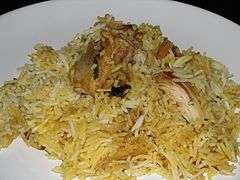 Awadhi chicken Dum Biryani.
Awadhi chicken Dum Biryani.- Pulav.
- Pullao
 Alu gobhi.
Alu gobhi. Breakfast.
Breakfast.- Chicken curry.
- Chicken Ginger.
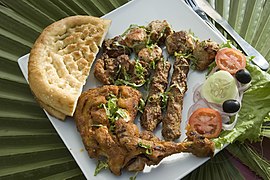 cooked under barbecue method.
cooked under barbecue method.
 Chicken curry with Chapati.
Chicken curry with Chapati. Uttar Pradeshi thali.
Uttar Pradeshi thali. Chicken pakauda avadhi cuisine.
Chicken pakauda avadhi cuisine. General veg thali.
General veg thali.- Fish curry.
- Fried Fish.
- Halva Poori.
- Haleem (Khichda).
 Tanduri chicken.
Tanduri chicken. Naan with fish curry.
Naan with fish curry. Samosa served with chutney.
Samosa served with chutney.
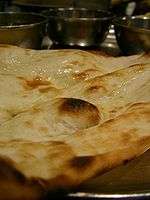 Naan a staple bread of Awadh.
Naan a staple bread of Awadh. Paratha served with tea.
Paratha served with tea.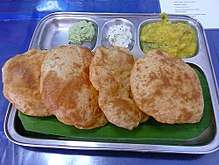 puri with accompaniments.
puri with accompaniments.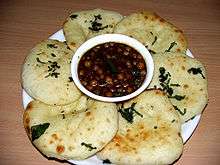 Kulcha with chhole.
Kulcha with chhole.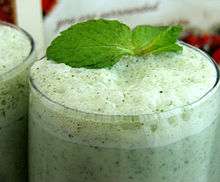 Mint salted lassi.
Mint salted lassi.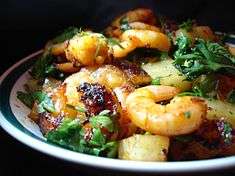 Awadhi prawns.
Awadhi prawns. Awadhi samosa.
Awadhi samosa.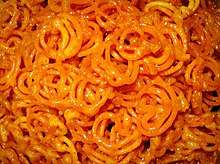 Awadhi jalebi.
Awadhi jalebi. Awadhi kheema.
Awadhi kheema. Awadhi gobhi.
Awadhi gobhi. Awadhi chaat.
Awadhi chaat. Naan with fish curry avadhi cuisine.
Naan with fish curry avadhi cuisine. Awadhi awadhi gobhi roti.
Awadhi awadhi gobhi roti. Awadhi oven chicken.
Awadhi oven chicken. Awadhi chana 2b.
Awadhi chana 2b. Awadhi chaat corner.
Awadhi chaat corner. Awadhi seekh kebab.
Awadhi seekh kebab. Awadhi light 2b.
Awadhi light 2b. Awadhi daal rice.
Awadhi daal rice. Awadhi chaat 2b.
Awadhi chaat 2b.
Recipes
Following is list of few Awadhi recipes:
- Almond Kulfi
- Almond Seera
- Badam Halwa
- Boondi Raita
- Carrot Halwa
- Chicken Korma
- Dahi Gosht
- Fish Kebab
- Galouti Kebab[10]
- Green Peas Paratha
- Gujia
- Gulab Jamun
- Gulkand Peda
- Imarti
- Indian Keema
- Jalebi
- Kachori
- Kaddu Ki Kheer
- Kanji Ke Vade
- Kathi Kebab
- Kele Ki Sabzi
- Khaja
- Kofta Curry
- Kurmura Ladoo
- Kuttu Paratha
- Lachcha Paratha
- Lamb kebab
- Malai Kofta
- Mango Burfi
- Methi Parathas
- Moong Dal Halwa
- Motichoor Ladoo
- Murgh Musallam
- Mushroom Biryani
- Mutton Kabab
- Naan
- Nargisi Kofta
- Navratan Korma
- Navratan Pulao
- Nawabi Curry
- Palak Paneer
- Paneer Korma
- Paneer Stuffed Tomatoes
- Paneer Tikka
- Papri
- Peas Pulao
- Phirni
- Rabdi
- Samosa
- Shahi Paneer
- Shami Kabab
- Tahari
- Thandai
- Til Papdi
- Vegetable Biryani
- Vegetable Pulav
- Yakhni Pulav
- Zafrani Kheer
- Zamin Doz Machhli
- Patili-ke Kebabs
- Ghutwa Kebabs
- Vegetable shami kabab
- Malpoa
- Rabadi
- Dahi balla
See also
References
- "Heaven On Your Plate: From kebabs to biryani, food is serious business in Lucknow". 23 April 2017.
- Mukherjee, Soma (2001). Royal Mughal Ladies and Their Contributions. ISBN 9788121207607. Retrieved 6 March 2015.
- The Sunday Tribune – Spectrum – Lead Article. The Tribune. (13 July 2003). Retrieved 2012-08-06.
- The Week. Week.manoramaonline.com. Retrieved 2012-08-06.
- "Yatra of Royal & Modern Cuisines of Awadh". Archived from the original on 9 January 2017. Retrieved 8 January 2017.
- Fisher, Michael H. (February 1977). "Lucknow: The Last Phase of an Oriental Culture. By Abdul Halim Sharar, Translated and Edited By E. S. Harcourt and Fakhir Hussain. London: Paul Elek, 1975. 295 pp. Illustrations, Maps, Notes, Bibliography, Index. £12.50". The Journal of Asian Studies. 36 (2): 366–367. doi:10.2307/2053751. ISSN 0021-9118. JSTOR 2053751.
- Jennifer Brennan, Curries and Bugles: A Memoir and a Cookbook of the British Raj, Tuttle, 2000, ISBN 9625938184
- Tastes of royalty. The Hindu. (19 July 2008). Retrieved 2012-08-06.
- Wallwork, Adrian (2014). "Using LinkedIn". CVs, Resumes, and LinkedIn. Springer New York. pp. 173–184. doi:10.1007/978-1-4939-1867-6_14. ISBN 978-1-4939-0646-8.
- "Awadhi Cuisine: Galouti Kebab Recipe".
External links
| Wikimedia Commons has media related to Awadhi cuisine. |